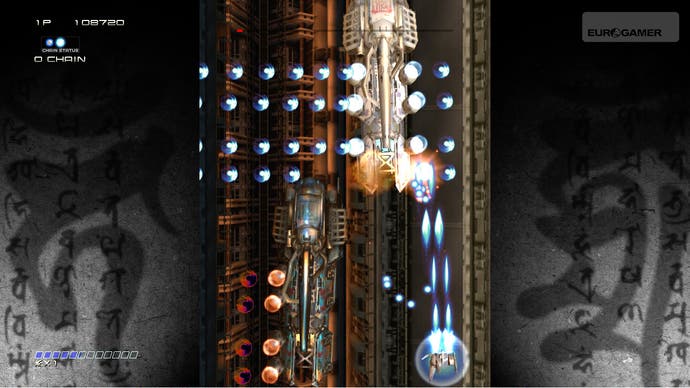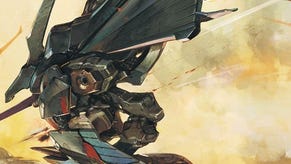Ikaruga
Radiant.
While broadening the definition of the genre, Treasure has also then, in a sense, narrowed it. This is a game of relentless, near-clinical precision, built for repeat-repeat-repeat-till you-get-it play that it will stifle players who don't fully commit to developing and perfecting a strategy. Seasoned shmup players are often lukewarm towards the game because you can't simply fall back on sharp reflexes and instinct alone. Success takes planning and practice. Whereas in Radiant Silvergun the colour-matching mechanics were totally optional, allowing the game to be played as a straight shoot-'em-up, here understanding and mastering the core idea is the key to success, a decision that splits the audience neatly in two: black, white, black, white.
So a shoot-'em-up with a good idea. What's the big deal? Well, while the game's mechanics are notable, in a sense it's the chassis and circumstance that have made it important. The utilitarian elegance that marks the game's core idea extends to its visuals in a remarkable fashion. Sunsets invade battleship blue skies, a cacophony of visual wonder built from a narrow colour palette of understated apricot hues mixed with cool iceberg blues. Patchwork quilt fields scroll miles below while exquisite ship, particle and lighting designs unfurl above. It's a game of such assured style to make most other games seem clumsy, juvenile and ridiculous by comparison.

The game found fame on the Dreamcast, arriving late into the beloved but ill-fated console's lifespan, but it was in the arcade that it debuted, the home console version but a twinkle in NAOMI's eye. A limited, Japanese-only production run made the game a desirable and expensive eBay item. This interest resulted in its acquisition by Atari for a GameCube release, where it subsequently found an evangelical fanbase. And now, finally, Ikaruga arrives on XBLA for the masses, complete with all of the leaderboard support it deserves at an irresistible price point.
The conversion is, to our hands, flawless. The screen (bordered at either side as the game was made for vertically-aligned arcade cabinets) can be stretched and moved to better fill modern widescreens and the resolution is higher than it has ever been. Likewise, whereas once dedicated players would need to import Japanese DVDs of the top players' score runs for tips and techniques, now you simply select their name on the scoreboard and sit back to watch their replay, awestruck. The option to save and upload all replays, combined with co-op play over Xbox Live, makes the definitive version of the game.
That said, there are scant few extras here, as if the four-man development team knew that the extraordinary challenge of making it through the game's five stages in a single credit while also vying for a high score would be content enough. There is no dead weight to the game, either in terms of presentation, design or content. You either fall for this Spartan approach or find its undiluted focus too much to bear. In Ikaruga there is no refuge, and there's honesty to this black and white approach that demands respect. But will that respect will turn to adoration? Well, that very much depends on how hard you'll work to make your own memories herein.


